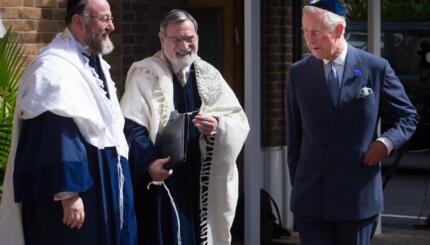In recent years, American Jewry has expressed concern about rising rates of intermarriage between Jews and non-Jews. However, intermarriage is by no means a recent phenomenon. Maintaining Jewish identity in a highly tolerant, secular American culture is a challenge that confronted American Jewry since the earliest settlements in the New World. The story of the Levy-Franks family, Jews immersed in the Protestant milieu of early eighteenth-century New York, is particularly illustrative.
The Franks family matriarch, (Bilhah) Abigail Levy Franks, was born in New York in 1696, one year after her parents, Moses and Rachel Levy, arrived there from London. Abigail’s beloved husband Jacob Franks also emigrated from London. He lived as a boarder in the Levy household and married 16-year old Abigail in 1712. Together, they had nine children, six of whom survived past infancy.
Both the Levy and Franks families were leaders of New York’s tiny Jewish community, which numbered fewer than 50 families. Jacob Franks served as parnas (president) of Shearith Israel congregation, the oldest Jewish congregation in North America. Yet the Levys and Franks included among their closest friends some of New York’s elite Protestant families: the Livingstons, Bayards, DeLanceys, and Van Cortlands. As ship owners and civic-minded New Yorkers, Moses Levy and Jacob Franks were among eleven Jews who contributed funds to complete the steeple of Trinity church, which served both as a religious symbol and as a beacon to guide ships into New York harbor.
At a time when women were meant to forego formal education and devote themselves to home and children, Abigail Levy’s parents provided her with a classical education. In her letters, she quoted from the contemporary novels of Fielding and Smollett, read the works of Dryden, Montesquieu, and Pope (her favorite author), and encouraged her daughters to do the same. Her hopes for her children are known to us today primarily through letters she wrote to her son Naphtali, who had gone to seek his fortune in London. Abigail’s remarkable correspondence resides today in the archives of the American Jewish Historical Society.
With your help, My Jewish Learning can provide endless opportunities for learning, connection and discovery.
(Image below: Abigail Franks’ letter to her son Naphtali, May 7, 1733. “…Still it Gives me a Seceret pleasure to Observe the faire Charecter Our Familys has in the place by Jews & Christians…” Courtesy of American Jewish Historical Society)

Abigail prided herself on her strict observance of the Sabbath, holy days, and dietary laws, as well as her regular attendance at Shearith Israel. Suspicious of the kitchens even of relatives, she repeatedly sent
food to son Naphtali in London and warned him not to eat anything at the home of his English uncle (her brother-in-law) “unless it be bread and butter . . . nor anywhere else where there is the least doubt of things not done after our strict Judaical method.”
While observing in colonial New York was manageable, finding suitable mates for her children in New York’s tiny Jewish community posed Abigail with more of a problem. With so few local Jewish suitors, she worried that her daughters would have to live, in her words, as “nuns.” To cope with the shortage of eligible Jewish mates for her sons, she encouraged Naphtali to marry his Jewish cousin in London. He followed his mother’s advice.
Abigail was therefore profoundly dismayed when, in 1743, her daughter Phila eloped with Oliver DeLancey, the son of a wealthy and politically powerful Christian family. Although her husband Jacob soon reconciled himself to Phila’s marriage because it allied the Franks clan with the well-connected DeLanceys, Abigail refused to speak to Phila or let Oliver in her home. There is no evidence that mother and daughter ever reconciled before her death. Jacob was heartbroken.
Paradoxically, in at least one instance, the appearance of a rare Jewish suitor for one of her daughters did not please Abigail. She opposed the courtship of her daughter Richa by a member of the New York Gomez family because she regarded the prospective bridegroom as a “stupid wretch.” Richa later rejected the proposal of a Christian suitor to avoid adding to her mother’s unhappiness. She finally married a Jew in England after her parents’ deaths. While Naphtali and his older brother both married Jewish first cousins, Abigail’s youngest son David married one of Philadelphia’s Christian belles.
The story of the Frank’s family marriages–and lack thereof–illustrates the dilemma young Jewish men and women faced when seeking spouses in colonial America. Abigail Franks’ New York was the home of only a few hundred Jews. London, Amsterdam, Berlin and other great European cities, by contrast, formed the center of Jewish life. To compound matters, New York’s Protestant elite considered the city’s Jews eligible marriage partners.
The dearth of potential Jewish partners and the acceptance that greeted the citys Jews is a challenge that the Franks family confronted 250 years ago. While the number of Jews in New York and America has increased exponentially, the question of how to maintain Jewish “continuity” in America’s socially tolerant environment remains as vital today as in the age of Abigail Franks.
Chapters in American Jewish History are provided by the American Jewish Historical Society, collecting, preserving, fostering scholarship and providing access to the continuity of Jewish life in America for more than 350 years (and counting). Visit www.ajhs.org.


